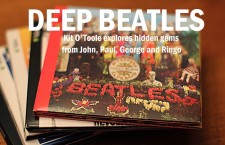While not considered one of their best-known tracks, 1967’s “Flying” represents a rarity for the Beatles: It was an instrumental, and it listed all four members as cowriters. In addition, it was the first and only Beatles-penned instrumental released by EMI. (They had recorded “Cry for a Shadow” in Hamburg, while they jammed on “12-Bar Original” during the Rubber Soul sessions).
Originally titled “Aerial Tour Instrumental,” the track “Flying” was intended as incidental music; it accompanies the psychedelic Magical Mystery Tour sequence featuring landscapes of Iceland. The footage derives from outtakes from Stanley Kubrick’s 1964 movie Dr. Strangelove or: How I Learned to Stop Worrying and Love the Bomb, and were altered with color saturation. As the bus travels, the tour guide directs the passengers’ attention to the trippy footage, with “Flying” perfectly enhancing the intended hallucinatory effect.
In Many Years from Now, Paul McCartney explains that the song originated from a late night recording session. Knowing that they needed instrumental music for the traveling scene, McCartney suggested that the band make up a song on the spot. “I said, ‘We can keep it very very simple; we can make it a twelve-bar blues. We need a little bit of a theme and a little bit of a backing,’” he told author Barry Miles. “I wrote the melody. The only thing to warrant it as a song is basically the melody, otherwise it’s just a nice twelve-bar backing thing. It’s played on the Mellotron, on a trombone setting. It’s credited to all four, which is how you would credit a non-song.”
Recording began at Abbey Road Studios on September 8, 1967; as usual, George Martin produced while Geoff Emerick and Ken Scott served as engineers. The lineup included John Lennon on Mellotron and Hammond organ; Paul McCartney on guitar and bass; George Harrison on guitar; and Ringo Starr on drums and maracas. In a rare move, all four contributed vocals, although they were of the “la la la” variety. The group recorded six takes of “Flying,” at this point involving only drums, organ, bass, and guitar. Three organ overdubs were also added, recorded with the tape running in reverse. Next, Lennon overdubbed the Mellotron replicating the trumpet; finally, the Beatles contributed their vocals.
On September 28, they added Starr’s maracas, Harrison’s acoustic guitar, and more Mellotron, this time on the flute setting. According to Kenneth Womack’s Beatles Encyclopedia, the Beatles also overdubbed a prerecorded Mellotron tape of a Dixieland band, while Lennon created sound samples of electronic noises, organ, and chimes. Eventually the group decided to eliminate the jazz band sample in favor of Lennon’s tape loops played in reverse. Finally, Martin, Emerick, and Scott completed two mono mixes of “Flying,” labeled five and six (four other mono mixes had been created on September 8); the latter was selected for the Magical Mystery Tour soundtrack.
While “Flying” may seem like an inconsequential instrumental, it demonstrates the influence the Beatles had on a popular music form: electronica. The track does not represent the group’s first experimentation with the Mellotron, as they used it to great effect on the pioneering single “Strawberry Fields Forever.” Harrison would further explore the instrument’s capabilities on his 1969 album Electronic Sound; while promoting the 2014 box set The Apple Years 1968-1975, son Dhani Harrison said the album foreshadows today’s EDM. “My dad was trying to understand synthesizers. If you look at how predominant those sounds are now. … Every synth and dance record ever made is in there,” he told David Fricke. Like Electronic Sound, “Flying” and its sonic enhancements represent another step in the development of modern electronica.
After releasing his 2016 album Blonde, R&B artist Frank Ocean cited the Beatles as a major influence on his electronic-themed work. “I want to thank the Beatles for almost single-handedly getting me out of writer’s block,” Ocean said on his radio show “Blonded” on Apple Music’s Beats 1. Proving his devotion, Ocean sampled several Beatles tracks on his album; interestingly, he includes elements of “Flying” on the song “Siegfried.” The psychedelic sound of the original certainly enhances the otherworldly elements of Ocean’s composition.
“Flying” may not be the Beatles’ best-known track, but it illustrates how the group embraced futuristic sounds and anticipated recording techniques that are commonplace today.
- The Rescued Early Paul McCartney Song That Completed ‘Beatles For Sale’ - December 4, 2024
- A Rare Beatles Cover Proves John Lennon Was Wrong About His Voice - November 26, 2024
- How John Lennon Came Roaring Back on the Beatles’ White Album - November 22, 2023


